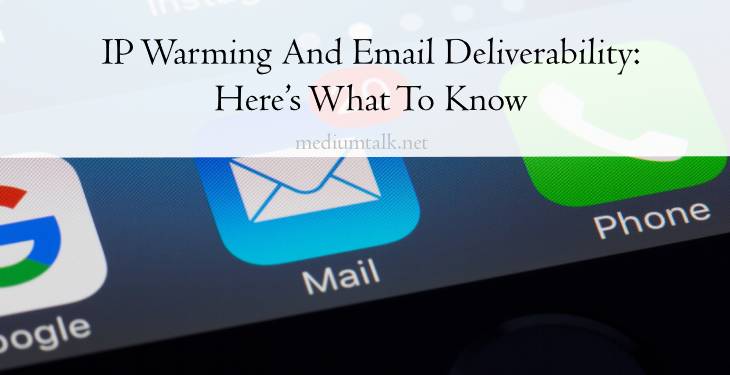Are your emails disappearing into the dreaded black hole of the internet? If you’ve been struggling to get your messages delivered to your customers’ inboxes, then it’s time to dive into the world of IP warming. This crucial aspect of email deliverability is often overlooked but can make all the difference in whether your carefully crafted content reaches its intended audience or gets lost in cyberspace. In this article, we’ll unravel the mysteries of IP warming and show you step-by-step what you need to know to boost your email deliverability and increase engagement with your subscribers.
What is IP warming and why is it important?
IP warming is the process of gradually increasing the sending volume and reputation of a new IP address over time. This practice is crucial for any organization that relies on email marketing as it helps build trust with internet service providers (ISPs) and ensures higher email deliverability rates.
During an IP warming period, you start by sending small volumes of emails to engaged recipients who have previously interacted with your brand. By gradually increasing the volume and maintaining positive engagement metrics such as open rates and click-through rates, ISPs begin to recognize your IP address as legitimate and trustworthy. This not only improves your deliverability but also helps establish a good sender reputation.
Many marketers underestimate the importance of IP warming, often believing that they can simply switch to a new IP address or use a pre-warmed one without consequences. However, failing to properly warm up an IP address can result in poor deliverability, increased spam complaints, or being blacklisted by ISPs. For this reason, it’s crucial to invest time and effort in an effective IP warming strategy to ensure your email campaigns reach their intended recipients’ inboxes consistently.

The basics of IP warming process
The IP warming process is an essential step in establishing a solid reputation for sending emails. When it comes to email deliverability, maintaining a positive sender reputation is crucial. IP warming helps build this reputation by gradually increasing the volume of emails sent from a new or dormant IP address. By starting with a low volume and gradually ramping up, you give ISPs (Internet Service Providers) the opportunity to monitor your sending behavior and determine if you are a legitimate, trustworthy sender.
During the IP warming process, it is important to pay close attention to engagement metrics such as open rates and click-through rates. These metrics help ISPs determine the quality of your emails and whether they are wanted by recipients. By monitoring engagement closely, you can identify any issues early on and make adjustments to improve deliverability.
Additionally, it’s worth noting that each ISP has its own algorithms for filtering spam and determining inbox placement. Therefore, it’s essential to tailor your IP warming strategy based on the preferences of your target audience and their preferred email providers. By understanding these nuances, you can better optimize your email campaigns for maximum deliverability throughout the IP warming process.
In conclusion, properly executing an IP warming process can significantly impact email deliverability. It allows senders to establish trust with ISPs while minimizing the risk of being flagged as spam. By gradually increasing email volumes and monitoring engagement metrics closely during this period, marketers can ensure their messages reach their intended recipients’ inboxes consistently at high percentages.
Benefits of IP warming for email deliverability
There are several benefits to engaging in IP warming for email deliverability. Firstly, IP warming allows you to build a positive reputation with email service providers (ESPs). By gradually increasing your sending volume over time, ESPs will see that you are a reputable sender and are less likely to flag your emails as spam or place them in the junk folder. This increases the likelihood of your emails reaching the recipients’ inbox and improving overall deliverability rates.
Secondly, IP warming helps you identify any potential deliverability issues early on. By closely monitoring your metrics during the warm-up process, such as open rates, click-through rates, and bounce rates, you can quickly identify any problems or patterns that may be affecting your email delivery. This allows you to take corrective actions promptly and proactively manage any challenges before they become significant obstacles.
Lastly, IP warming gives you an opportunity to segment your audience effectively. During the warm-up phase, it is essential to send emails only to engaged subscribers who have opted in explicitly for communication from your brand. By segmenting these individuals from less active subscribers during this period, you improve engagement levels and reduce the risk of negative interactions with ISPs.
In conclusion, implementing an IP warming strategy can significantly enhance your email deliverability by establishing a positive reputation with ESPs and identifying potential deliverability issues early on. It also allows for effective audience segmentation during the warm-up process. By taking these steps towards improving email deliverability through proper IP warming techniques, businesses can achieve higher inbox placement rates.

Best practices for successful IP warming
Successful IP warming is crucial for establishing a positive reputation and maximizing email deliverability. One best practice to keep in mind is starting with a low volume of emails and gradually increasing it over time. This allows internet service providers (ISPs) to get familiar with your IP address and ensures that you don’t trigger their spam filters. Additionally, segmenting your subscriber list based on engagement levels can help improve inbox placement rates during the warming process. By prioritizing active subscribers who regularly open and click on emails, you increase the chances of landing in their primary inbox.
Another best practice is to monitor your email engagement metrics closely throughout the warming phase. High bounce rates, low open rates, or excessive complaints could indicate issues with sender reputation or targeting suspicious recipients. Identifying these problems early on allows you to take corrective measures promptly so that they don’t impact deliverability in the long run. It’s also important to remember that maintaining consistent sending patterns during IP warming can be advantageous for building trust with ISPs, ensuring a smooth transition and avoiding any sudden changes that might raise red flags.
Implementing these best practices offers significant benefits when it comes to successfully warming up an IP address for optimal email deliverability. By gradually increasing your sending volume, focusing on engaged subscribers, monitoring key metrics, and maintaining consistent patterns throughout the process, you establish a solid foundation for long-term success in reaching subscribers’ inboxes effectively.
Common challenges and how to overcome them
One common challenge in IP warming is managing sender reputation. When you start sending emails from a new IP address, email service providers (ESPs) and internet service providers (ISPs) have no historical information about your sending practices. This lack of reputation can result in lower deliverability rates or even having your emails marked as spam. To overcome this challenge, it is crucial to gradually increase the volume of emails you send and closely monitor the response rates, engagement metrics, and overall deliverability.
Another challenge is effectively segmenting your email list during the warm-up process. Without proper segmentation, you risk sending irrelevant content to subscribers, which can lead to disengagement or even unsubscribes. To overcome this hurdle, take time to properly segment your audience based on preferences, interests, demographics, and past interactions with your brand. By delivering personalized and targeted content that resonates with each segment of your list during IP warming, you are more likely to maintain high engagement rates and improve overall deliverability.
In summary, managing sender reputation by gradually increasing email volume and close monitoring is key in overcoming one of the most common challenges in IP warming. Additionally, effective segmentation allows for personalized content delivery during the warm-up process and helps maintain subscriber engagement levels. By proactively addressing these challenges head-on with strategic approaches tailored to your specific audience and needs,you can successfully navigate the complexities of IP warming while optimizing email deliverability rates.

Conclusion: Importance of implementing proper IP warming
In conclusion, the importance of implementing proper IP warming cannot be overstated. It serves as a crucial step in establishing a positive reputation for your email sending infrastructure. By gradually increasing your sending volume and ensuring that you’re delivering valuable content to engaged recipients, you not only avoid triggering spam filters but also build trust with internet service providers (ISPs). This trust is essential for achieving high deliverability rates and reaching the inbox of your subscribers.
Moreover, proper IP warming should be viewed as an ongoing process rather than a one-time activity. As your email program evolves and you start sending larger volumes or targeting different segments, it’s important to continue monitoring your sending reputation and adjusting your warm-up strategy accordingly. This adaptability ensures that your emails continue to land in the inbox rather than being relegated to the dreaded spam folder.
In today’s competitive digital landscape, where businesses are vying for their audience’s attention through email marketing campaigns, understanding and implementing proper IP warming techniques can provide a significant advantage. By taking the time to nurture relationships with ISPs and gradually building up your mail volume over time, you can enhance both deliverability rates and overall customer engagement.
